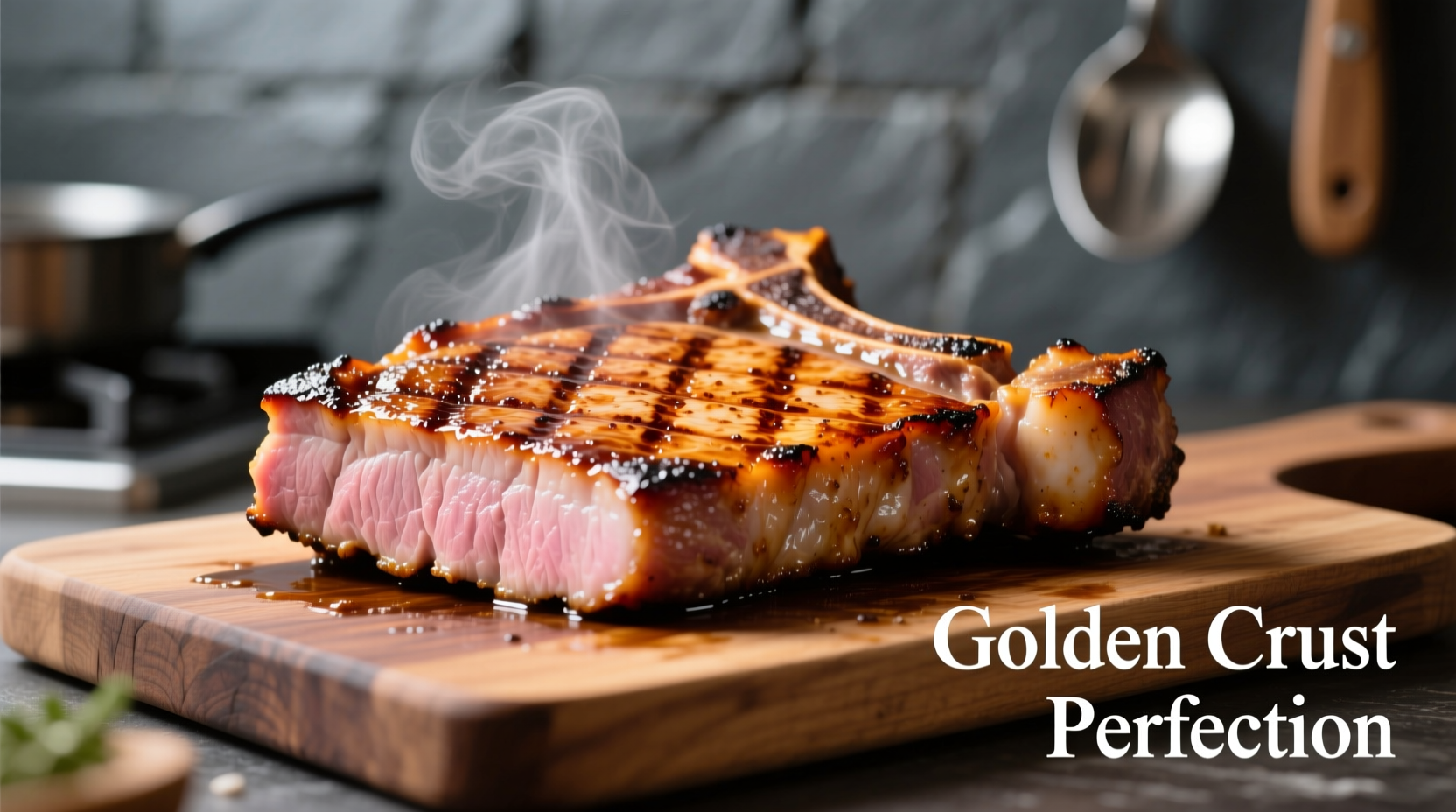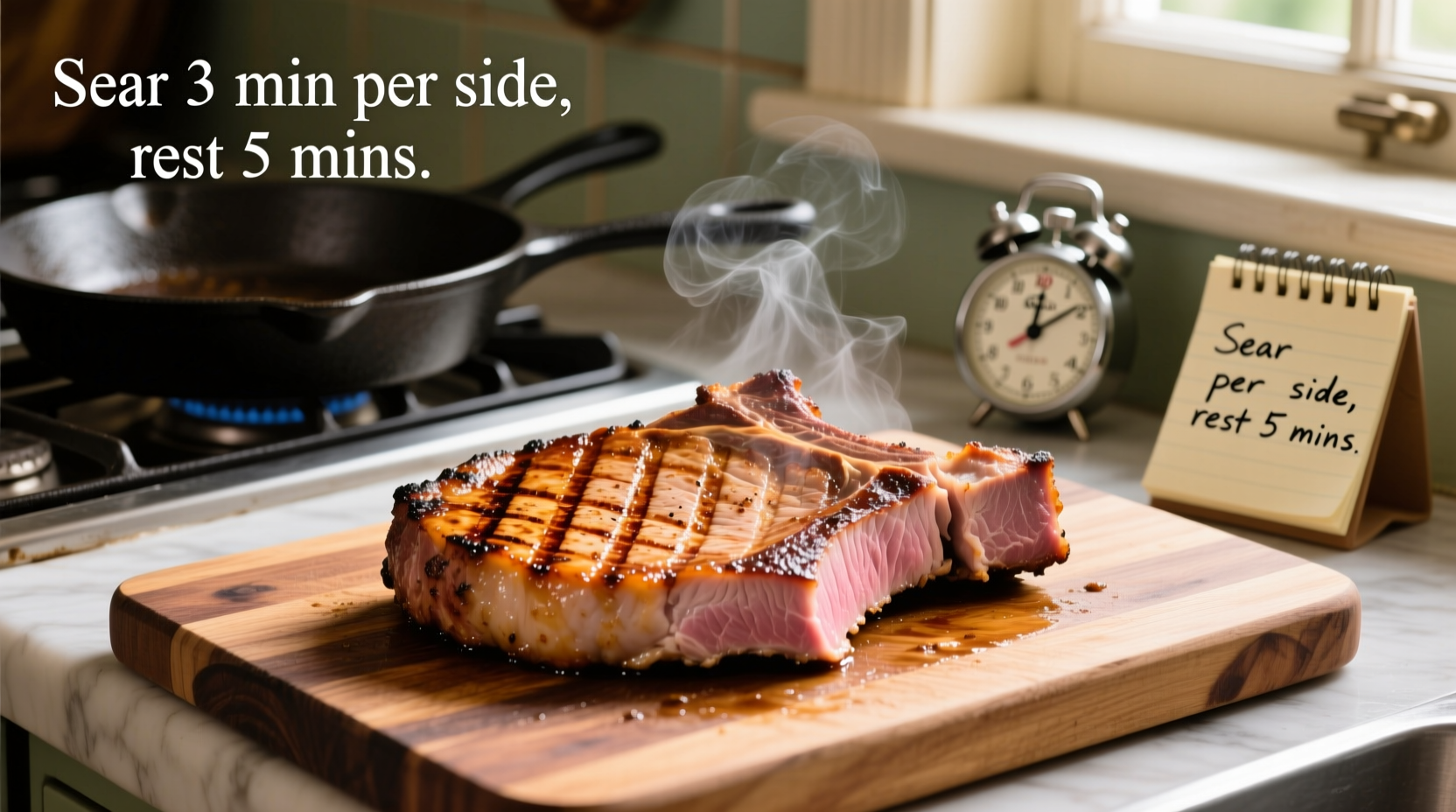USDA recommends cooking pork chops to a safe internal temperature of 145°F (63°C), followed by a 3-minute rest. Actual cooking time varies significantly based on thickness, cooking method, and starting temperature—typically 4-6 minutes per side for 1-inch chops on the stovetop or grill.
Ever wonder why your pork chops turn out dry despite following "perfect" cooking times? The secret isn't just in the clock—it's understanding how thickness, heat source, and carryover cooking work together. This guide delivers precise cooking times backed by food science, USDA safety standards, and professional chef techniques to ensure juicy, flavorful pork chops every time.
Quick Reference: Pork Chop Cooking Times at a Glance
| Cooking Method | Thickness | Time Per Side | Target Internal Temp |
|---|---|---|---|
| Stovetop (Cast Iron) | 1 inch | 4-6 minutes | 140°F (before resting) |
| Grill (Medium-High) | 1.5 inches | 5-7 minutes | 140°F (before resting) |
| Oven (400°F) | 1.5 inches | 12-15 minutes total | 140°F (before resting) |
| Air Fryer (375°F) | 1 inch | 8-10 minutes total | 140°F (before resting) |
Why Cooking Time Alone Isn't Enough
Professional chefs know that timing is just one piece of the puzzle. The USDA's Food Safety and Inspection Service confirms that pork chops must reach 145°F internal temperature with a 3-minute rest for safe consumption—a significant update from the old 160°F guideline. But here's what most home cooks miss: cooking time varies dramatically based on three critical factors:
- Thickness matters most: A 1.5-inch chop needs nearly 50% more time than a 1-inch chop
- Starting temperature affects cooking speed: Chops straight from the fridge take 25% longer than room-temperature meat
- Carryover cooking raises temperature: As explained by the American Meat Science Association, meat continues cooking 5-10°F after removal from heat due to residual heat transfer
Stovetop Method: Perfect Sear Every Time
For the classic restaurant-quality crust, follow this chef-tested approach:
- Pat chops dry with paper towels (moisture prevents browning)
- Season and let sit at room temperature for 30 minutes
- Heat cast iron skillet over medium-high until water droplets sizzle
- Cook 1-inch chops 4-6 minutes per side until reaching 140°F internally
- Remove when thermometer reads 5°F below target (140°F for 145°F final)
According to culinary research from the University of California's Agriculture and Natural Resources department, the Maillard reaction (that delicious browning) occurs most effectively between 285-325°F—explaining why medium-high heat works better than maximum heat for perfect searing without burning.

Grilling Guide: Avoiding Common Pitfalls
Grilling introduces additional variables that change cooking times significantly:
- Direct vs. indirect heat: Start over direct heat for searing (2-3 minutes per side), then move to indirect heat to finish cooking
- Thermometer placement matters: Insert probe horizontally through the side to measure center temperature accurately
- Wind and ambient temperature: On cold days, add 15-20% to cooking times as noted in USDA's outdoor cooking guidelines
Food Network's test kitchen found that bone-in chops require 1-2 minutes longer per side than boneless equivalents due to the bone's insulating effect—a crucial detail often overlooked in generic cooking charts.
The Critical Resting Period: Why 3 Minutes Makes All the Difference
That mandatory 3-minute rest isn't just for safety—it's where the magic happens. During this time:
- Temperature equalizes throughout the chop (carryover cooking)
- Proteins relax, allowing juices to redistribute
- Final texture becomes noticeably more tender
Cover loosely with foil to retain heat, but don't wrap tightly—that traps steam and softens your beautiful crust. Serious Eats' culinary experiments demonstrated that rested pork chops retain up to 40% more moisture than those sliced immediately.
Troubleshooting Common Pork Chop Problems
Dry, tough chops? You're likely overcooking. Remember: 145°F is the safe minimum, not a target to exceed. Use an instant-read thermometer religiously.
Bland flavor? Brine chops in 4 cups water with 1/4 cup salt and 2 tbsp sugar for 30-60 minutes before cooking. This simple step, recommended by the National Pork Board, enhances both moisture retention and seasoning penetration.
Inconsistent doneness? For thicker chops (1.5+ inches), try reverse searing: bake at 275°F until 130°F internally, then sear for 60-90 seconds per side. This method, validated by America's Test Kitchen, delivers perfect edge-to-edge doneness.
When to Trust Your Thermometer Over the Clock
Visual cues like juice color or firmness can mislead even experienced cooks. The only reliable method is an instant-read thermometer. Insert horizontally into the thickest part, avoiding bone:
- 140°F: Remove from heat (will rise to 145°F during rest)
- 145°F: Perfect medium (slightly pink center)
- 150°F+: Well-done (increasingly dry texture)
The USDA's Food Safety Education resources emphasize that color alone cannot indicate doneness—pork can remain slightly pink even when properly cooked to 145°F, which is completely safe.











 浙公网安备
33010002000092号
浙公网安备
33010002000092号 浙B2-20120091-4
浙B2-20120091-4